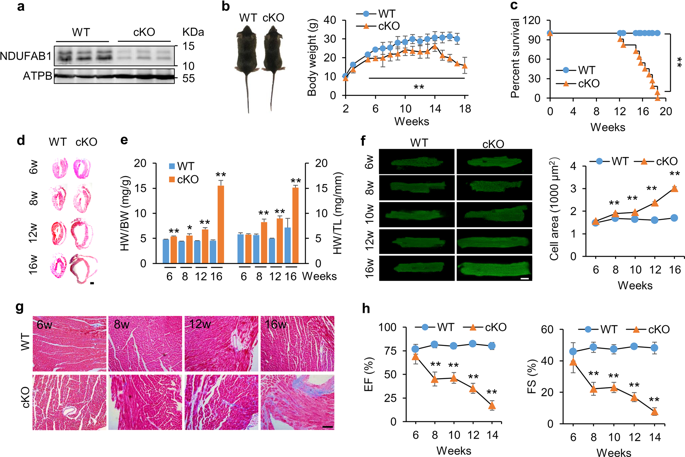Cell Research ( IF 28.1 ) Pub Date : 2019-07-31 , DOI: 10.1038/s41422-019-0208-x Tingting Hou 1 , Rufeng Zhang 1 , Chongshu Jian 1 , Wanqiu Ding 1 , Yanru Wang 1 , Shukuan Ling 2 , Qi Ma 1 , Xinli Hu 1 , Heping Cheng 1 , Xianhua Wang 1

|
The impairment of mitochondrial bioenergetics, often coupled with exaggerated reactive oxygen species (ROS) production, is a fundamental disease mechanism in organs with a high demand for energy, including the heart. Building a more robust and safer cellular powerhouse holds the promise for protecting these organs in stressful conditions. Here, we demonstrate that NADH:ubiquinone oxidoreductase subunit AB1 (NDUFAB1), also known as mitochondrial acyl carrier protein, acts as a powerful cardio-protector by conferring greater capacity and efficiency of mitochondrial energy metabolism. In particular, NDUFAB1 not only serves as a complex I subunit, but also coordinates the assembly of respiratory complexes I, II, and III, and supercomplexes, through regulating iron-sulfur biosynthesis and complex I subunit stability. Cardiac-specific deletion of Ndufab1 in mice caused defective bioenergetics and elevated ROS levels, leading to progressive dilated cardiomyopathy and eventual heart failure and sudden death. Overexpression of Ndufab1 effectively enhanced mitochondrial bioenergetics while limiting ROS production and protected the heart against ischemia-reperfusion injury. Together, our findings identify that NDUFAB1 is a crucial regulator of mitochondrial energy and ROS metabolism through coordinating the assembly of respiratory complexes and supercomplexes, and thus provide a potential therapeutic target for the prevention and treatment of heart failure.
中文翻译:

NDUFAB1通过协调呼吸道复合体和超复合体装配增强线粒体生物能,从而赋予心脏保护作用。
线粒体生物能学的受损,通常与夸张的活性氧(ROS)产生有关,是包括心脏在内的对能量的高需求器官的基本疾病机理。建立一个更强大,更安全的蜂窝发电站有望在压力条件下保护这些器官。在这里,我们证明了NADH:泛醌氧化还原酶亚基AB1(NDUFAB1),也称为线粒体酰基载体蛋白,通过赋予更大的线粒体能量代谢能力和效率,可以充当强大的心脏保护剂。尤其是,NDUFAB1不仅充当复合物I亚基,而且还通过调节铁硫生物合成和复合物I亚基稳定性来协调呼吸复合物I,II和III以及超复合物的组装。心脏特异性缺失小鼠中的Ndufab1导致生物能缺陷和ROS水平升高,导致进行性扩张型心肌病,并最终导致心力衰竭和猝死。Ndufab1的过表达有效增强了线粒体的生物能,同时限制了ROS的产生,并保护了心脏免于缺血再灌注损伤。在一起,我们的发现表明,NDUFAB1通过协调呼吸复合体和超复合体的组装,是线粒体能量和ROS代谢的关键调节剂,从而为预防和治疗心力衰竭提供了潜在的治疗靶点。











































 京公网安备 11010802027423号
京公网安备 11010802027423号